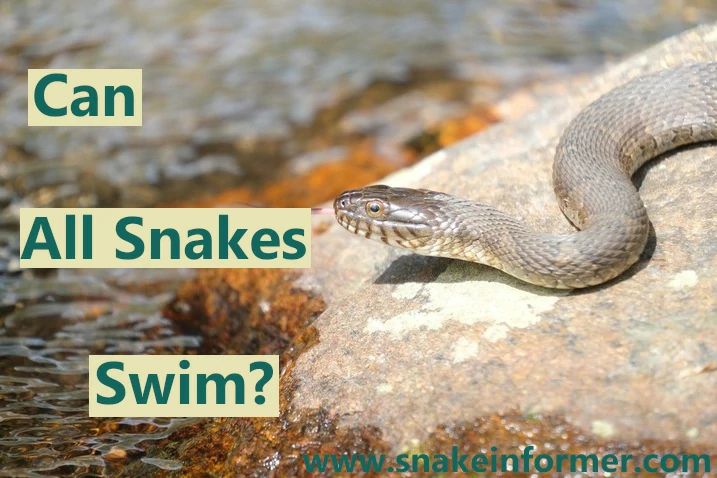There are over 4,000 identified snake species worldwide, found in a wide variety of habitats, from rain forests to mountainous areas to dry regions. Different snake species have adapted to their environments and specialize in moving over the terrain most common in their habitats.
Generally, all snakes can instinctively swim from the moment of their birth. They swim by winding their bodies in an ‘S’ shape, while they keep their heads above the water.
That said, some snakes are more comfortable in the water and are stronger swimmers than others.
All Snakes Can Swim
Most snakes are naturally buoyant and can instinctively swim when they get into the water.
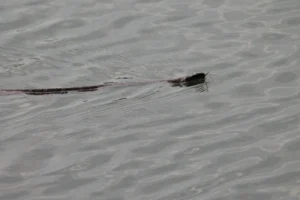
They swim in a similar way to how they move on land: by winding their bodies from side to side while keeping their heads above the water.
Snakes that are highly adapted for swimming can hold their breath and dive underwater, staying submerged for a few minutes before returning to the surface.
Some Snakes Are Stronger Swimmers Than Others
Although all snakes can swim, some snakes are more comfortable in the water and are stronger swimmers than others.
In general, snake species that live closest to marshes, ponds, streams, and lakes tend to be better swimmers than species that typically occur further inland.
There are many different species of snakes called ‘water snakes’ that are characterized by their semi-aquatic lifestyle.
These snakes are highly adapted for swimming and can hold their breath and dive underwater, staying submerged for a few minutes before returning to the surface.
A few sea snake species can even stay submerged for up to 8 hours!
On the other hand, highly terrestrial snakes often do not have the ability to dive underwater for significant periods.
Why Do Snakes Swim?
Snakes have a very wide distribution and can be found on every continent, except Antarctica.
For this reason, these reptiles have adapted to effectively move through a wide variety of habitats.
Most snakes can swim, move across sand, and even climb trees, with relative ease.
Here are a few things that snakes use their swimming ability for:
1. Hunting
All snakes are obligate carnivores. Their ability to swim is very important as they hunt for prey, near water bodies.
They can catch snails, leeches, earthworms, frogs, toads, salamanders, toads, newts, and even small fish in the water.
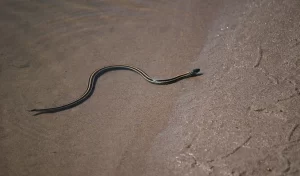
Snakes are generally not picky eaters, and will catch almost any prey they can catch and swallow whole (snakes do not chew their food).
They use their sense of smell, as well as their vision to detect and hunt for prey.
2. General Locomotion
Swimming is an efficient way for snakes to move around, in an environment with lots of water bodies.
They will regularly swim across small ponds to get to areas with better food better food, hiding spots, or other resources needed for their survival.
Often, snakes will swim simply to move across different areas of their habitat.
3. Predator Avoidance
Many snakes are eaten by a wide variety of predators, such as crows, hawks, foxes, raccoons, and even larger snakes.
For this reason, these reptiles developed several ways to defend themselves.
As a first line of defense, most snakes will remain motionless, and rely on their camouflage to blend into their environment. Their coloration makes them hard to see in grassy areas.
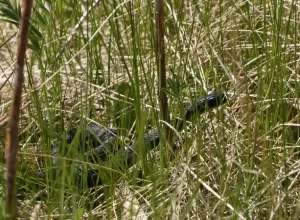
However, when they are spotted by a predator, snakes may attempt to escape.
Their ability to swim means they can flee into the water to quickly escape predators on land.
Can Snakes Breathe Underwater?
Like all reptiles, snakes have lungs, that they use to breathe air.
Despite their various adaptations and ability to swim, snakes generally can not breathe underwater.
Most snakes only move on the water’s edge, or in shallow water, and do not stay submerged for long.
The Snakes That Are Known to Breathe Underwater
Although most snake species can not breathe underwater, some snake species have been found to have the ability to breathe underwater.
A team of researchers analyzed the bodies of two blue-banded sea snakes (Hydrophis cyanocinctus) – and discovered a gill-like network of blood vessels in the animals’ heads.
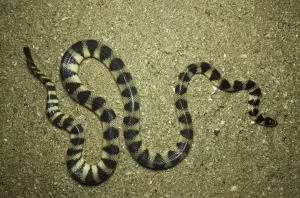
This complex system of blood vessels is known as a modified cephalic vascular network (MCVN).
It is located just under a broad area of skin between the snout and the roof of the snake’s head.
While the MCVN is structurally very different from the gills of fish, its function is similar. It provides a large surface area packed with oxygen-depleted blood vessels.
The oxygen-poor blood in these vessels is able to absorb oxygen from the surrounding water – through the skin.
The blood oxygenated blood is then carried to the brain – very similar to how a fish’s gills work.
In this way blue-banded sea snakes use the top of their head, as a sort of gill, to breathe underwater.
This ‘skin breathing’ is known as cutaneous respiration, and is very unusual for reptiles, because their skin is thick and scaly.
Although the ability to breathe underwater has only been found in sea snakes, it is still interesting to consider. With further scientific studies, this ability may also be found in other snake species.
Conclusion
Snakes live in a wide variety of environments, and often encounter water bodies in their habitats.
These reptiles frequently venture into the water and are excellent swimmers.
Many snakes also find a large portion of their prey in or near water. They hunt frogs, toads, newts, snails, leeches, earthworms, and even small fish.
In general, amphibians tend to make up a significant part of many snakes diets.
Apart from hunting, snakes also rely on their swimming ability to move between different parts of their habitat – and also to escape land predators.
Sources:
Guillaume Fosseries, Anthony Herrel, et al. Can all snakes swim? A review of the evidence and testing species across phylogeny and morphological diversity, Zoology, Volume 167, 2024, 126223, ISSN 0944-2006, https://doi.org/10.1016/j.zool.2024.126223.
Hi, my name is Ezra Mushala, i have been interested animals all my life. I am the main author and editor here at snakeinformer.com.

